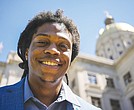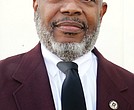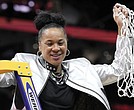Melvin 'Mel' Tull
Spotlight on board chair of Children’s Home Society of Virginia
11/22/2019, 6 a.m.
November is National Adoption Month, and the Children’s Home Society of Virginia is highlighting the best of their work with profiles of successful adoptive families in the Richmond area in hopes of encouraging the public to provide a loving home for Virginia’s youths in foster care. CHSVA has connected more than 700 youths and families across Virginia during the past year under the direction of leaders like Melvin “Mel” Tull, its board chairman.
“Adoption is an amazing gift,” Mr. Tull says. “It is not only a gift for the child who is striving to overcome difficult circumstances, but it is a gift for the family who takes that child into their home to give them the love and attachment that will allow them to heal.”
Established on Jan. 30, 1900, by founders concerned about the abandonment of children and the state of or- phanages at the time, CHSVA is focused on building “strong permanent families and lifelong relationships for Virginia’s at-risk children and youths,” according to Mr. Tull. This includes matching youths in foster care with adoptive families and training and supporting those families for the responsibility. CHSVA also assists those who have aged out of the foster care system before being adopted with housing and support.
The Henrico County resident who will celebrate his birthday on Friday, Nov. 22, splits his time between work duties as general counsel and senior vice president of Bankers Insurance, family responsibilities and his volunteer position with CHSVA.
Mr. Tull believes that “attorneys and other professionals have a duty to devote a portion of their time and expertise to serving less fortunate under- served communities in our society.”
“Serving on the board of CHSVA gives me an opportunity to use my experience advising businesses and boards of directors to improve the lives of children in foster care and young adults that age out of foster care,” Mr. Tull says. Mr. Tull has focused his two-year tenure as board chair on helping staff find “long-term, sustainable sources of income” for CHSVA programs, solidifying the 75 percent of the agency’s $1.6 million budget that isn’t covered by partnerships with the Department of Social Services or fees for services. Mr. Tull also wants to make “diversity, inclusion, equity and sustainability” a continuing priority in the development of the board of directors.
A key part of both initiatives is engagement, Mr. Tull says, connecting with community partners with similar values and goals and getting board members involved in the groundwork done by CHSVA staff to give them a better perspective on the work being done. All of this contributes to the positive influence their efforts have for youths in need of a home and a loving family.
Meet this week’s Personality and adoption advocate, Melvin “Mel” Tull:
No. 1 volunteer position: Chair, Children’s Home Society of Virginia’s board of directors.
Occupation: Senior vice president for strategic business development and general counsel for Bankers Insurance, LLC, an independent insurance agency.
Date and place of birth: Nov. 22 in Baltimore.
Current residence: Short Pump in Henrico County.
Alma maters: Bachelor’s in accounting, Virginia Tech, 1991; and law degree, University of Virginia, 1997.
Family: Wife, Dr. Annemarie Tull, and children, Lauren, 20; Michael, 16, and Kathryn, 14.
CHSVA’s mission: To build strong permanent families and lifelong relationships for Virginia’s at-risk children and youths.
How CHSVA accomplishes its mission: By matching children and youths in the foster care system with adoptive families, training those families and then supporting those families for as long as they need it. We also provide housing and full wraparound supports to youths who have aged out of the foster care system to enable them to become independent adults.
Agency’s No. 1 challenge: Sustainable funding for all of our programs.
My No. 1 CHSVA project: To continue to strengthen and engage our board with the goals of diversity, inclusion, equity and sustainability being paramount.
Strategy for achieving it: We want to engage a diverse group of community partners whose values and goals align with ours. We also want to give our board members opportunities to become involved in the work we do at CHSVA so they can see first-hand the tremendous work that our staff does every day.
Number of children served by CHSVA: CHSVA served more than 700 children, youths and families during the past year.
Age groups of children: Most of the children served by CHSVA are 10 years old and older. CHSVA focuses on the adoption of older youths, sibling groups and special needs children from the foster care system. The Possibilities Project is our program for youths who have aged out of the foster care system without being adopted. TPP serves young adults ages 18 to 25.
Reasons children are in foster care: Children are placed in foster care for a number of reasons. Most often it is the result of abuse or neglect by the biological parents. Sadly, an increasingly common reason is opioid abuse by the parents. Many of the children in the foster care system have experienced childhood trauma. To address this, our programs are all trauma-informed and we work with adoptive parents to help them learn how to effectively parent children who have experienced abuse and neglect.
Advice for families considering adoption: Learn everything you can and have an open mind. There are numerous resources on our website, chsva.org. In addition, periodically we hold information sessions for folks interested in adopting. Finally, when you decide to adopt, make sure you take advantage of the training offered on parenting children who have been in foster care and make sure that training is trauma-informed. Please contact us to set up an individual orientation.
Myths about adopting teens in foster care: A couple of myths are that it is expensive and that you have to be in a traditional, two-parent relationship to adopt. Adoption of a teen out of foster care is not expensive and, in fact, assis- tance is offered to help offset the cost of a youth’s care in addition to a tax credit and college tuition support. We have same-sex couples and single parents adopt every year. The only requirement is that you provide a stable and loving home that is a good match for the young person.
Difference between a foster parent and foster-to-adopt parent: A foster parent may not have the plan to adopt the child who is in their care. Sometimes this is because the child’s parental rights have not been terminated and there is a goal of re-unification with the biological family. Once parental rights have been terminated, CHSVA goes to work to find families who have a goal of adoption and who are a good fit for the child. Once the child is placed, there is a requirement that the child be in the placement for at least six months before the adoption can be finalized. That is what is meant by foster-to-adopt.
Relationship children have with biological family once placed with adoptive families: It can vary greatly. While in some cases a relationship with some of the biological family is appropriate and even encouraged, in some cases, where there may have been severe abuse or neglect, such a relationship may be counterproductive. As part of our Post Adoption Club respite program, many times siblings who have been adopted in different families will come together on those days to reconnect and have some fun together.
The Possibilities Project is:
An award-winning program designed to encourage independence for young adults who have aged out of the foster care system. Sadly, Virginia is 49th out of 50 states for the rate at which youths age-out. Of youth who age out, nearly 50 percent will be homeless or incarcerated within two years and 70 percent of the young women become pregnant. Our program, which is a collaborative effort with the Better Housing Coalition, seeks to disrupt cycles of despair by providing housing and full wraparound supports such as financial literacy training, life skills training, educational and job assistance, mental health counseling and permanent mentoring relationships. We have graduated several young adults from our program who are now independent and on their own, one of whom will graduate from Virginia State University this fall.
How I start the day: I like to exercise first thing in the morning. I find it energizing and empowering.
A perfect day for me is: A day where I get a lot done, cross a lot of things off my “to-do” list, which then allows me to relax in the evening with a sense of accomplishment.
If I had more time, I would:
Spend more time running, bik- ing, hiking and participating in other outdoor activities and spend more time reading for pleasure.
Something I love to do that most people would never imagine: Hiking vacations. In recent years, my family spent time hiking in Alaska, the Grand Canyon, Peru’s Machu Picchu and Iceland.
A quote I am inspired by:
“Luck is what happens when preparation meets opportunity.” ― Seneca.
How I unwind: Any form of exercise — swimming, biking, running, hiking, strength training, etc.
The person who influenced me the most: Nadine Marsh- Carter, president and chief executive officer of CHSVA, has been an inspiration to me in the 10 years I have served on the board. Nadine is a rare individual who is at home in a board room full of corporate and community leaders and can also tell touching stories to a room full of potential donors about the challenges foster kids face with such compassion, empathy and sincerity that tears well up in their eyes and they reach for their wallets.
Book that influenced me the most: “A Random Walk Down Wall Street: The Time-Tested Strategy for Successful Investing,” by Burton G. Malkiel.
What I’m reading now: “Dope-sick: Dealers, Doctors, and the Drug Company that Addicted America,” by Beth Macy.
My next goal: Find new ways to provide leadership and advice to successful, high-performing organizations like CHSVA.







